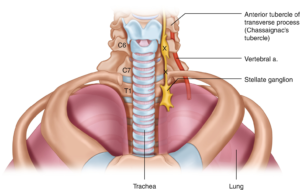Ashmore Osteopathic Group
ph: (07) 5597 5711 email: receptionostpath@gmail.com
What is PTSD/PTSI? How does Stellate Ganglion Block work?
The stellate ganglion block (SGB) is a procedure in which an injection of a long-acting local anaesthetic, using ultrasound, is made in the right side of the neck around the main nerve that controls the “fight or flight” response (the sympathetic nervous system).  Stellate ganglion block for PTSD/PTSI and Reflex Sympathetic Dystrophy (RSD), Sympathetic Maintained Pain and Complex Regional Pain Syndrome for the upper extremity has been traditionally performed on the right side at the sixth cervical vertebra (C6) level based on our understanding of the essential role of the right hemisphere in the human stress response. This nerve, (the cervical sympathetic chain) which is a two-way conduit, connects the parts of the brain that control the fight or flight response (referred to as the central autonomic network) to the rest of the body. By blocking or “turning off” the traffic in the cervical sympathetic chain, it is believed that the parts of the brain that control the fight or flight response are allowed to completely reset, resulting in long-term relief of the associated anxiety symptoms. Multiple peer-reviewed medical studies show that a right-sided SGB results in significant long-term improvement in chronic anxiety symptoms associated with post-traumatic stress injury (PTSI) and chronic pain and Complex Regional Pain Syndrome (CRPS) . The SGB takes less than 15 minutes to perform, and benefits are seen in as little as 30 minutes.
Stellate ganglion block for PTSD/PTSI and Reflex Sympathetic Dystrophy (RSD), Sympathetic Maintained Pain and Complex Regional Pain Syndrome for the upper extremity has been traditionally performed on the right side at the sixth cervical vertebra (C6) level based on our understanding of the essential role of the right hemisphere in the human stress response. This nerve, (the cervical sympathetic chain) which is a two-way conduit, connects the parts of the brain that control the fight or flight response (referred to as the central autonomic network) to the rest of the body. By blocking or “turning off” the traffic in the cervical sympathetic chain, it is believed that the parts of the brain that control the fight or flight response are allowed to completely reset, resulting in long-term relief of the associated anxiety symptoms. Multiple peer-reviewed medical studies show that a right-sided SGB results in significant long-term improvement in chronic anxiety symptoms associated with post-traumatic stress injury (PTSI) and chronic pain and Complex Regional Pain Syndrome (CRPS) . The SGB takes less than 15 minutes to perform, and benefits are seen in as little as 30 minutes.
Although the term PTSD is more commonly used, we feel that the term post traumatic stress injury (PTSI) is medically more accurate. After all, an injury is something you can recover from.
Post-traumatic stress disorder / Post-traumatic stress injury (PTSD/PTSI) is defined by the Diagnostic and Statistical Manual of Mental Disorders (DSM-5) as a pathologic trauma and stressor disorder that occurs in some individuals following exposure to severe trauma.
PTSD CheckList: http://traumadissociation.com/pcl5-ptsd
A stellate ganglion block (SGB) is a treatment approach for post-traumatic stress disorder/injury (PTSD – PTSI). Post-Traumatic Stress Disorder develops in response to being exposed to extreme stress, serious injury, psychological terror, childhood trauma and/or sexual assault. The symptoms of PTSD can present themselves as an assortment of psychiatric conditions: Nightmares, severe anxiety, insomnia, hyper-vigilance and over reactivity being the most pronounced. The sympathetic nervous system (“fight or flight”) has been long known to play a part in PTSD. It is believed that extra nerves of this system sprout or grow after extreme trauma leading to elevated levels of norepinephrine (an adrenaline-like substance) which, in turn, over activates the amygdala (the fear centre of the brain). This chain of events results in PTSD symptoms that may persist for years.
A part of the sympathetic nervous system, called Stellate Ganglion (a collection of nerves in the neck) seems to control the activation of the amygdala via the excess production of nerve growth factor. A recent innovation offers potential in rapidly treating symptoms of PTSD which have persisted for a prolonged period of time. Placing an anesthetic agent on the stellate ganglion, in an anesthetic procedure called Stellate Ganglion Block (SGB) can relieve the symptoms of PTSD in as little as 30 minutes and last for years. SGB “reboots” the sympathetic nervous system to its pre-trauma state, similar to a computer reboot. In the brain, norepinephrine levels are rapidly reduced and the extra nerve growth is removed. SGB is an anaesthetic procedure that has been performed since 1980’s and is considered a low risk procedure done under ultrasound guidance.
Stellate Ganglion Block (SGB) is not a cure for PTSD/PTSI, however, it is a highly effective, well tolerated, fast acting, inexpensive biologic technique that provides prolonged relief from the debilitating symptoms of PTSD and chronic pain. It will likely become a large part of the solution for patients with PTSD/PTSI.
Stellate Ganglion Block Facts & Information
A stellate ganglion block (SGB) delivers a small dose of anaesthetic medication to a group of nerves, the stellate ganglion, that is found in front of your neck, on either side of the voice box. These nerves are part of the sympathetic nervous system, an important messaging network that controls key body functions, such as heart rate, blood flow, and sweat secretion.
Importantly, the sympathetic system organises, processes, and sends messages from the brain to the rest of the body in response to stress, known as the “fight or flight” response. In certain conditions, like PTSD-PTSI, the sympathetic system can become overactive, resulting in abnormal and unwanted effects such as irritability, anxiety, chronic upper limb pain and sleep disturbances.
Sympathetic overactivity plays a role in pain conditions that affect the neck, head, chest, and arms. These include complex regional pain syndrome (CRPS), phantom limb pain, post-herpetic neuralgia (post-shingles pain), and painful vessel spasms that are seen in angina (chest pain) and Raynaud’s disease.
Cost of the Procedure $675
How Do Stellate Ganglion Blocks Help?
 A SGB quiets the nerve information transmitted by the sympathetic nervous system for the period that the local anaesthetic is effective (up to 5-7 hours). The block is useful in resetting the sympathetic nervous system to its normal resting state returning normal neuroplasticity to the central nervous system. (Neuroplasticity is the ability of the brain to form and reorganise synaptic connections, especially in response to injury/trauma).
A SGB quiets the nerve information transmitted by the sympathetic nervous system for the period that the local anaesthetic is effective (up to 5-7 hours). The block is useful in resetting the sympathetic nervous system to its normal resting state returning normal neuroplasticity to the central nervous system. (Neuroplasticity is the ability of the brain to form and reorganise synaptic connections, especially in response to injury/trauma).
During the procedure, your practitioner injects a particular pain-numbing medicine around the stellate ganglion. This can turn off pain and relax blood vessels, offering much-needed relief to people with neuropathic and/or vascular pain.
What does SGB treat?
In clinical practice SGB has successfully been used to treat other anxiety conditions such as vasomotor symptoms associated with menopausal hot flashes, as well as helping reduce symptoms during treatment for substance addiction.
SGB is not a treatment for depression, bipolar disorder, schizophrenia or any variants of schizophrenia, personality disorders or seizure disorders.
How does SGB work to help PTSD symptoms?
The stellate ganglion is part of the cervical sympathetic chain, a key part of the sympathetic nervous system (the “fight or flight” nervous system.) In PTSI and some other anxiety conditions, the “fight or flight” nervous system gets stuck in the “ON” position. By precisely placing a long-acting local anaesthetic (ropivacaine) around the stellate ganglion, the unproductive and chronic “fight or flight” response is turned off for several hours. This allows neurotransmitters in the brain to “reset” back to a non-anxiety state. This “resetting” results in long-term relief of anxiety symptoms. The SGB may improve daily activities, sleep, relationships, mood, employment and more.
How Long does the Procedure Take and Is It Safe?
Stellate ganglion injections are quickly and safely performed under ultrasound guidance. Because it affords greater accuracy and permits visualization of critical soft tissue structures, ultrasound guidance utilises lower volumes of injectate, in addition to greater safety and efficacy. The procedure typically takes less than 20-25 minutes to perform and is followed by a short recovery period before you are discharged home.
How Often Should this Procedure be Done?
Usually, injections are performed two to three weeks apart. A set of three injections is common, although the timing and number of injections can vary depending on the condition and the response. You may gain considerable relief after the first or second injection. In that instance, further injections may not be necessary.
What are the Expected Results?
Immediately following the procedure, you may temporarily experience a droopy eyelid, a stuffy nose, sinus congestion, warmth in the arm, transient headache, hoarseness and dysphagia. We recommend that you avoid strenuous exercise the day of the procedure. You may return to normal activities 24-36hrs following the procedure.
Some people experience immediate pain relief after the injection, while others experience a slower onset of relief within a few days. How long the pain relief lasts is different for each patient.
Note: In the treatment of PTSD/PTSI, patients often feel a reduction in anxiety the day of the procedure, with a significant reduction in irritability, intrusive thoughts, panic attacks, and sleep disturbances for the weeks to months following the procedure.
Stellate Ganglion Block..
ANATOMY – The cervical sympathetic chain is made up of the – superior, middle, & inferior cervical ganglia. In 80% of the population, the inferior cervical ganglion is fused with the first thoracic ganglion, forming the CERVICOTHORACIC or the STELLATE ganglion at the region of chassaignac’s tubercle.
The ganglion is oval shaped 2.5 x 1 x 0.5 cm at the level of C7-T1, anterior to the transverse process of C7 & 1st rib & longus coli muscle. Nearby structures include the brachial plexus, spinal nerve roots, the prevertebral portion of the vertebral artery and carotid sheath.
STELLATE GANGLION BLOCK TECHNIQUES
US GUIDED C6 transverse process approach – Position & Needle insertion site at Carotid Sheath and SCM muscle retracted laterally with transducer – Pressure is applied with the transducer – reduce the distance between the skin and tubercle – depresses dome of lung to reduce risk of pneumothorax – The needle is inserted towards to the Chassaignac’s tubercle, The needle is then withdrawn 1-2 mm to bring it out of the longus colli muscle while still staying within the prevertebral fascia. After negative aspiration, 4-5 mL of local anaesthetic (0.2% Ropivicaine) can be injected in 1ml aliquots, and the spread can be visualised with ultrasound. Once confirming that the injection was subfascial, the remaining local anesthetic can be given.
C7 Anterior Approach – Nearly identical to the C6 approach. Performed with US Guidance – Anatomical landmarks are more difficult to identify because the C7 vertebra has only a vestigial anterior tubercle that is not readily palpable. Risk of pneumothorax and vertebral artery injury is higher. Advantages – Needle is closer in proximity to ganglion . A smaller volume of local aneasthetic is delivered with more reliable and consistent blockade. Particularly useful when we encounter a failed blockade at the c6 level.
Both before and after the procedure, the patient is specifically counselled on potential for and signs of life-threatening adverse effects, including worsening neck pain which may indicate hematoma formation, shortness of breath which could indicate pneumothorax or temporary blockade of the phrenic nerve, or seizure which would indicate inadvertent intravascular uptake of the local anaesthetic.
- Mulvaney SW, Curtis KE, Ibrahim TS (2020) Comparison C6 Stellate Ganglion versus C6 and C4 Cervical Sympathetic Chain Blocks for Treatment of Post-traumatic Stress Disorder (PTSD): Analysis of 147 Patients. J Neurol Disord Stroke 7(3): 1163.